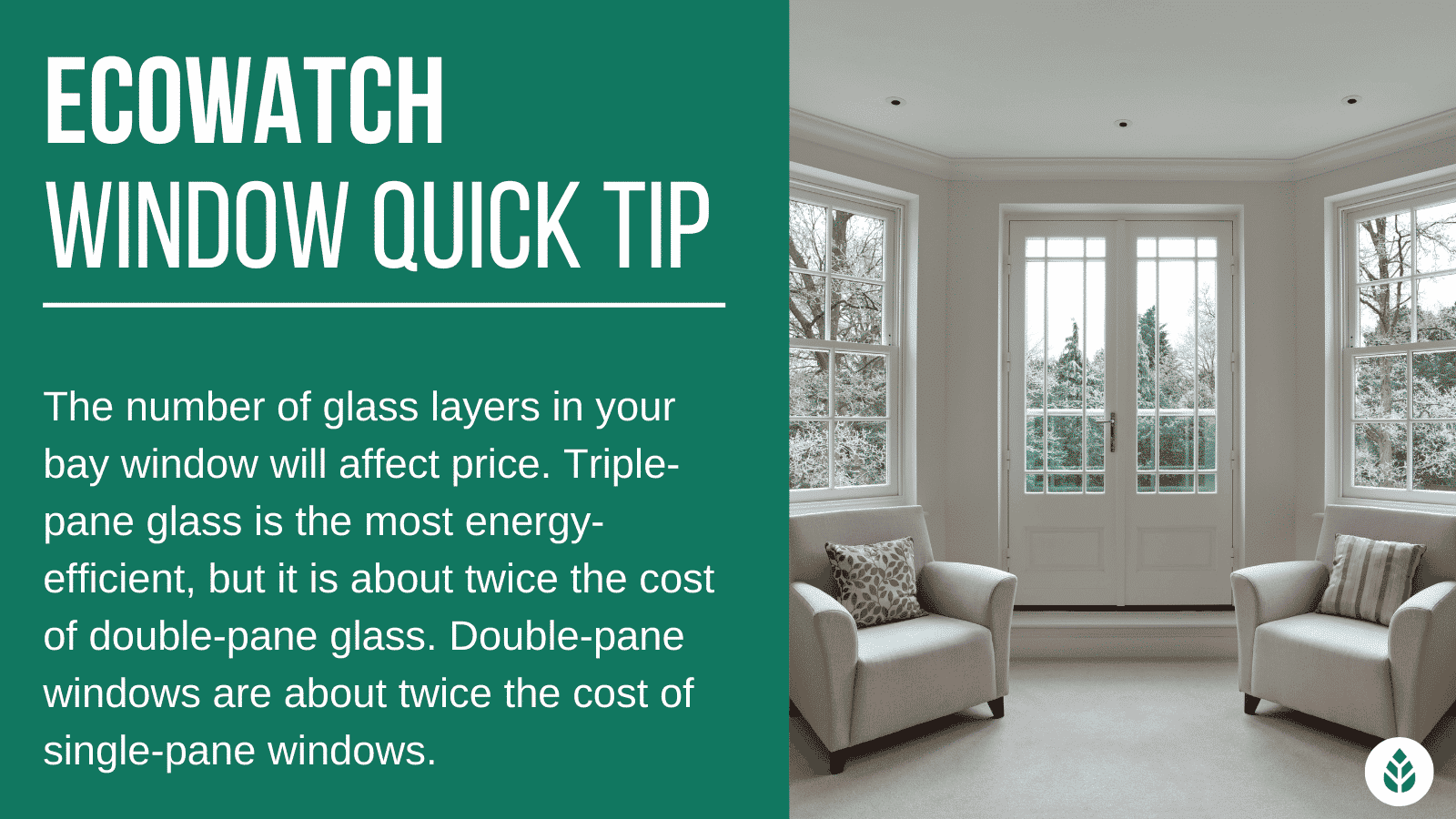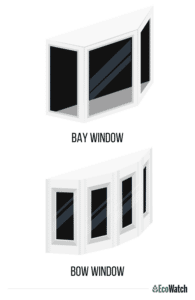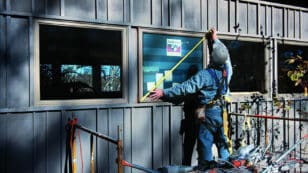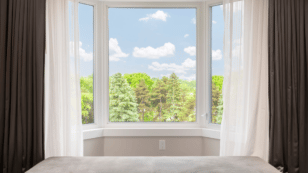
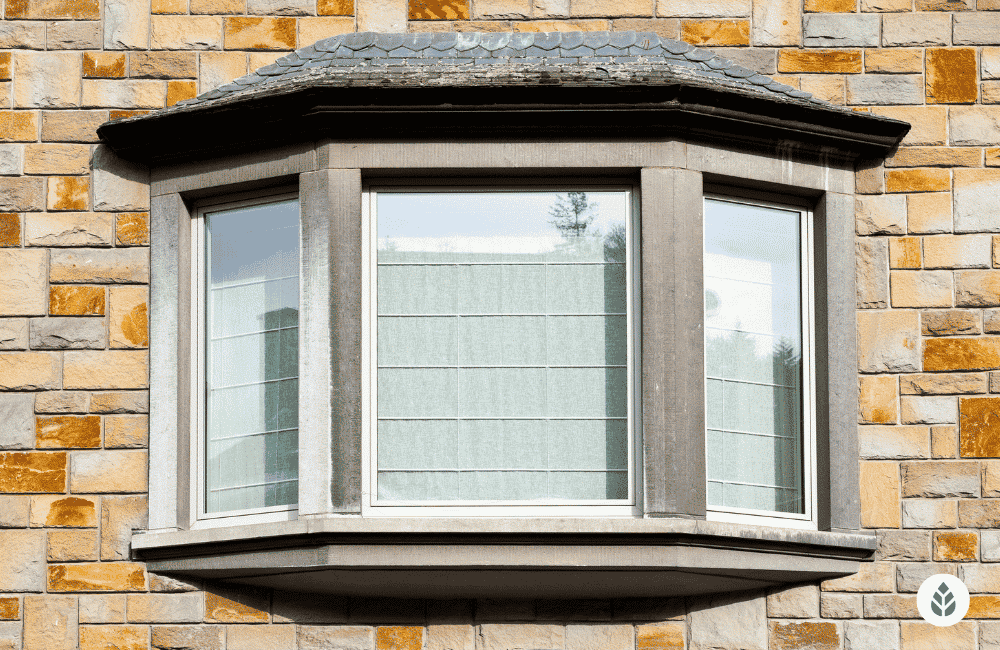
How Much Does a Bay Window Cost to Install? (2024)
In this guide on bay window cost, you’ll learn:
- How much does it cost to install a bay window?
- What factors affect the pricing of bay window installation?
- What’s the difference between bay windows and bow windows?
- Can you install a bay window yourself?
If you are interested in installing a bay window but need more information on pricing, then this guide will help ensure that you make the right window decision for you home. Enter your zip code below to receive a personalized quote on window options near you.
Each product and or company featured here has been independently selected by the writer. You can learn more about our review methodology here. If you make a purchase using the links included, we may earn commission.
Our team used automation tools when creating this article. However, we manually reviewed and fact-checked all information prior to publishing.
If you’re thinking about installing a bay window in your home for more natural light or better views, or you need to replace an existing bay window to improve energy efficiency, you’re in the right place.
Bay windows add curb appeal to your home, introduce ample natural light into your living space and give you beautiful views of the outdoors. However, they’re much more costly to install and replace than most other window types because of the increased material cost and the labor that goes into installing such a large window.
In this article, we’ll discuss the national average cost of bay windows, the factors that can affect your pricing, the possibility of completing a DIY bay window installation and much more.
How Much Does It Cost to Install a Bay Window?
The national average cost to install a bay window is around $2,200. Depending on the size, brand and several other factors, most homeowners can expect to pay between $750 and $5,000 for their bay window installations.

Renewal by Andersen

Save $375 Off Each Window
Average cost
Pros
- Great industry reputation
- Award-winning company
- Member of US Green Building Council
- Manufactures products in-house
Cons
- No lifetime warranty
- More expensive than competition

Window World

200 Locations Nationwide
Average cost
Pros
- EnergyStar Partner
- Large service area
- Wide variety of products and services
- Great industry reputation
- Lifetime warranty
Cons
- Quality of service will depend on your area

Window Nation

9 States (75 miles from showrooms)
Average cost
Pros
- Award-winning company
- Wide variety of products and services
- Manufactures products in-house
- Custom Designs
Cons
- Installation not covered by warranty
- Limited service area
What Factors Affect the Cost of Installing a Bay Window?
The price range of installing a bay window is so wide because there are quite a few factors that can have an impact on your pricing. Below, we’ll discuss the most significant project cost factors that will determine if your bay window installation falls around the $750 minimum or closer to the $5,000 maximum price.
New Bay Window vs. Bay Window Replacement Cost
One of the most important factors to consider is whether you’re installing a new bay window or if you’re instead replacing an existing bay window.
Installing a new bay window where one doesn’t already exist involves creating a wall opening, reframing the opening to support the fixed window and maintain your home’s structural integrity and then installing the new window. On average, a new bay window installation cost will be around $2,500, although the bay window price can range quite a lot depending on the location and other factors described below.
Replacing a bay window comes out to a slightly lower average of around $2,200. The work is a bit less involved, but the old window needs to be removed and hauled away, which adds to the total cost.
Bay Window Size
The size of your bay window will affect the cost of both materials and labor. Larger windows naturally cost more because they use more materials. Below are some average prices for different bay window sizes:
- 4’ wide x 3’ tall: $1,400
- 6’ wide x 3’ tall: $2,200
- 8’ wide x 3’ tall: $2,800
- 10’ wide x 3’ tall: $3,400
Larger windows can also come with higher labor costs, as bigger, heavier windows require more window installation technicians to assist. The price of labor is included in the average costs above.
Frame Material
As is the case with any window, the frame material can have a drastic effect on your total installation cost. Window frames come in several options including aluminum, vinyl, wood, composite and fiberglass. The type of material you choose will affect your overall cost as well as the curb appeal, customization options and more.
Here’s a quick overview of window frame materials:
Aluminum bay windows tend to be some of the most affordable, averaging around $1,600 for the window and installation. Aluminum is the least energy-efficient frame material, but it’s also very low maintenance.
For homeowners looking for greater thermal capabilities to maximize home energy efficiency, vinyl bay windows are a great affordable option. Vinyl can’t be painted, so you won’t be able to customize your bay window. However, the cost is relatively affordable at around $1,800.
Some vinyl bay windows have voids built into the frame that you can fill with foam insulation. These tend to be a bit more costly, but they’re also far more efficient in terms of insulating your home.
Wood bay windows come in at around $2,000, on average, so they’re just a little more costly than aluminum and vinyl. Wood bay windows aren’t as energy efficient as those with vinyl frames, but some homeowners prefer the appearance.1
Composite frames are made from wood fibers and other materials, and they tend to be more insulative than standard wood. They’re also slightly less expensive in most cases.
Fiberglass frames make for the most energy-efficient windows and the most durable option, but they’re also the most expensive. A single fiberglass bay window averages around $2,800.
Energy Efficiency
Larger windows will naturally be less energy-efficient than similar smaller windows because glass doesn’t have as high a thermal value as a solid insulated wall. Being large, bay windows aren’t the most thermally protective, so many homeowners strive to get the most efficient window options available. Generally speaking, the more insulative your bay window is, the more costly it will be.
The glass type in your bay window can have an impact on your cost. Some types of bay windows in areas where the climate isn’t extreme are single-pane, meaning there is one layer of glass with no insulation.
Double-pane windows have two layers of glass with a vacuum-sealed layer of argon gas or krypton gas between them. Triple-pane glass has three panes of glass with two layers of insulative gas. Triple-pane windows can be about twice as expensive as double-pane windows, which in turn can be about twice as expensive as single-pane bay windows.
Window glass coatings and treatments can improve your home’s energy efficiency, but they also drive up your cost. For example, low-emissivity (Low-E) coatings can improve the thermal value of your window glass, but they come with an added cost.
Window tinting is another option that helps reduce the heat transfer through your window and the intensity of the sunlight in your home. Both of these glass treatments can lower your energy bills over time and eventually pay for themselves.
Window Brand
As is the case with any home improvement, the brand of the materials can have a significant effect on the cost of installing a new bay window. Some brands — like Renewal by Andersen, Pella, Milgard and Marvin — are more costly for the same size windows and same materials from lower-quality brands — like Harvey, Simonton and JELD-WEN.
When it comes to windows, you generally get what you pay for, which is to say that saving money up-front by choosing lower-tier window brands can often come back to haunt you. Higher quality windows might cost more, but they’ll usually save you more on your energy bills in the long run and tend to be more durable so you’ll need to replace them less often.
Additional Work Required
In some cases, your bay window installation will involve additional work such as reframing parts of your wall or ensuring that the structural integrity of your home isn’t compromised. As you might expect, any added work required will drive up your labor costs and, as a result, your installation total.
If you have an existing bay window, when it’s removed, your contractor might uncover a structural problem or evidence of a leak that wasn’t previously apparent. If that’s the case, you’ll need to correct the problem before the new window is installed. Depending on which window installation company you choose to tackle your window project, the technicians might be able to address the issue themselves. In any case, this added work will impose additional costs.
Full bay windows usually need some sort of overhang to ensure water doesn’t pool on top of the window and make its way inside. If your bay window isn’t installed under an area with soffits, your window contractor might need to install a bay roof — a small section of angled roofing that directs water away from your home and toward the front of the bay window. If you need a bay roof installed along with your window, you can expect to add a few hundred dollars in costs.
Location of the Window
Finally, the location of your bay window can affect the price, as some installation sites are more challenging than others. For example, installing a bay window on the ground level in your home is relatively straightforward and shouldn’t take more than two or three laborers. If you’re instead installing it on your second floor, your installation team will likely be larger and will need a window lift to get the window into position. More work and more equipment equate to higher prices.
Similarly, if you have obstructions outside where you want your window installed — like trees growing close to the house or a pond — your cost might be slightly higher because of the inconvenience or additional tools and equipment needed to work around it.
Benefits of Installing a Bay Window
You’ll enjoy many benefits from a bay window, which is why many homeowners happily pay a premium for this window style. We’ll discuss the most significant upsides below.
Curb Appeal
One of the biggest reasons homeowners opt for bay windows is the curb appeal they add to the home. Bay windows break up the monotony of standard-sized double-hung windows, single-hung windows and picture windows, and they give your home a sense of character and charm.
Increased Property Value
Along with increased curb appeal comes a bump in your home’s value. The value of your home is determined by buyers, and installing something as appealing as a bay window is a surefire way to make your home more attractive to buyers. When you go to sell, some estimates suggest you could get up to 80% of the bay window cost back in the price of your home.
Abundant Natural Light
Bay windows are significantly larger than most standard windows, so they allow tons of natural light into your living space. They are particularly desirable in areas where homeowners spend time during the day and entertain, as they bring a warmth to the room that light fixtures never will.
Better Views of the Outdoors
As some of the largest windows available, bay windows also give you a clear and unimpeded panoramic view of the outdoors. Even if you’re just looking out at your neighbors’ properties, the view can be quite appealing.
Increased Interior Living Space
Finally, bay windows draw out your home’s exterior walls and make the space inside feel bigger, which is great for smaller rooms that need storage space or rooms like living rooms and dining rooms used to entertain. Window seats can also be incorporated into bay windows.
Bay Window vs. Bow Window vs. Box Window
Many homeowners confuse bay windows with less-common bow windows. Given how similar they are, it’s an easy mistake to make.
Bay windows have three faces: two side windows that pull out from the exterior wall at an angle — these are often casement windows — and one wider center window that runs parallel to the exterior wall and connects to the two side windows. Bay windows average around $2,200 to install.
A bow window has more than three faces to create a bow shape that pulls out from the exterior wall. Some can have six or seven faces for a true bow shape. Bow windows don’t jut out from the wall as much as bay windows do and often can’t accommodate window seating. They’re far more expensive than bay windows to install — averaging around $5,000.
Box windows — also called box bay windows — are similar to bay windows, but the two side faces extend out from the exterior wall at a 90-degree angle. Box windows are commonly small windows installed over kitchen sinks.
Cost of a DIY Bay Window Installation
Given the relatively high cost of installing a bay window, some homeowners understandably wonder if DIY installation is an option. If you do a DIY installation for your bay window, you could stand to save an average of $500 or more on your installation costs.
While it certainly is possible, there are some things you should understand first, and there are cases where hiring a professional is a necessity.
DIY vs. Hiring a Professional
If you’re particularly handy and have some friends or family members who can help you pick up and maneuver the window into position, it’s possible to replace a bay window yourself. This should only ever be done if you’re replacing the existing window with a new window that’s exactly the same size. Reframing your wall is a potentially dangerous endeavor that could cause structural damage to your home.
DIY bay window installation should also only ever be attempted on a first floor. Windows on upper floors are inherently more difficult to install, and even professionals require special equipment to lift the window into place.
Finally, you should only ever attempt DIY bay window installation if you can afford to go without a window for a few days. In other words, don’t attempt to replace your bay window in the dead of winter, if the summer heat is intense or if it’s expected to rain. If you run into an issue — like window damage, unexpected water intrusion behind the old window or structural issues with load-bearing walls — you’ll need to be able to call a professional in to finish the job without putting you or your home at risk while you wait.
FAQ: Bay Window Cost
Most homeowners can expect to pay around $2,900 for an Andersen bay window, or anywhere between $1,800 and $3,500, depending on the size and materials.
The likelihood is that you will need a permit. Many municipalities require permits for any renovations that could cause structural damage. A permit can take a few days to a few weeks for approval, and they can add around $50 to $200 to your installation costs, depending on where you live.
Building permits might seem like unnecessary red tape, but they ensure that your window is installed properly and that your home remains structurally stable after the installation.
Bay windows have three faces, two of which push out from your exterior wall at an angle, and the third of which runs parallel to the wall and connects to the other two. Bow windows have more than three faces and produce a rounded rather than an angled appearance to your row of windows. Bay windows are much less expensive on average and provide interior seating options. Bow windows are more costly and don’t add as much room to your living space.
One of the best ways to save money when installing a bay window is to upgrade to highly energy-efficient glass and frame materials. Choosing fiberglass window frames and double-pane or triple-pane glass will drive up your up-front costs, but they can also save you quite a lot on energy bills over cheaper, less insulative materials.
You can also save money in the long run by choosing a reputable window installation company that provides a long-lasting warranty. Higher quality companies will tend to be a bit more costly, but again, they stand to save you money if you run into issues with your window in the future.

 233k
233k  41k
41k  Subscribe
Subscribe 
